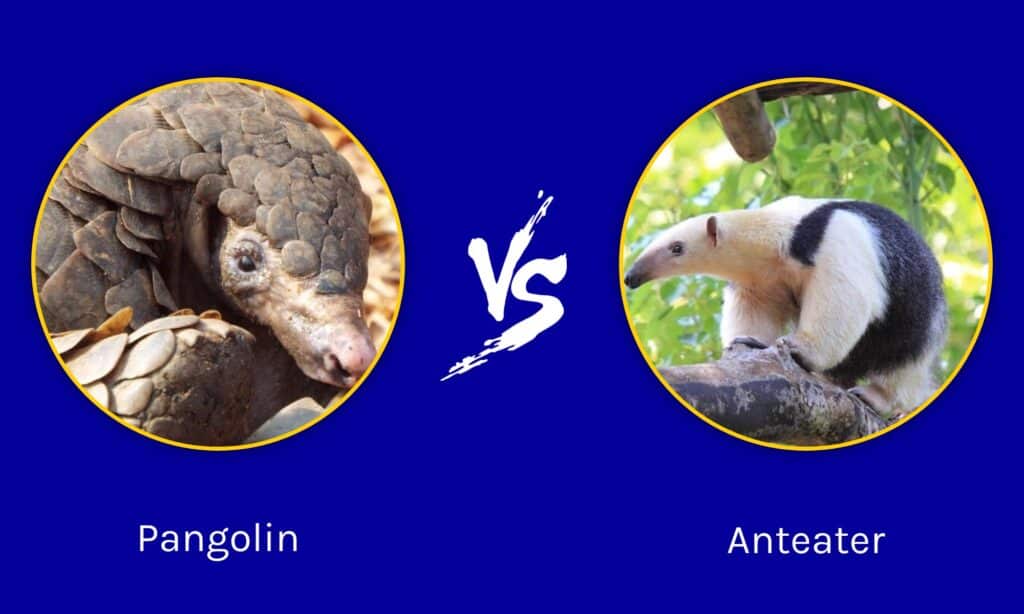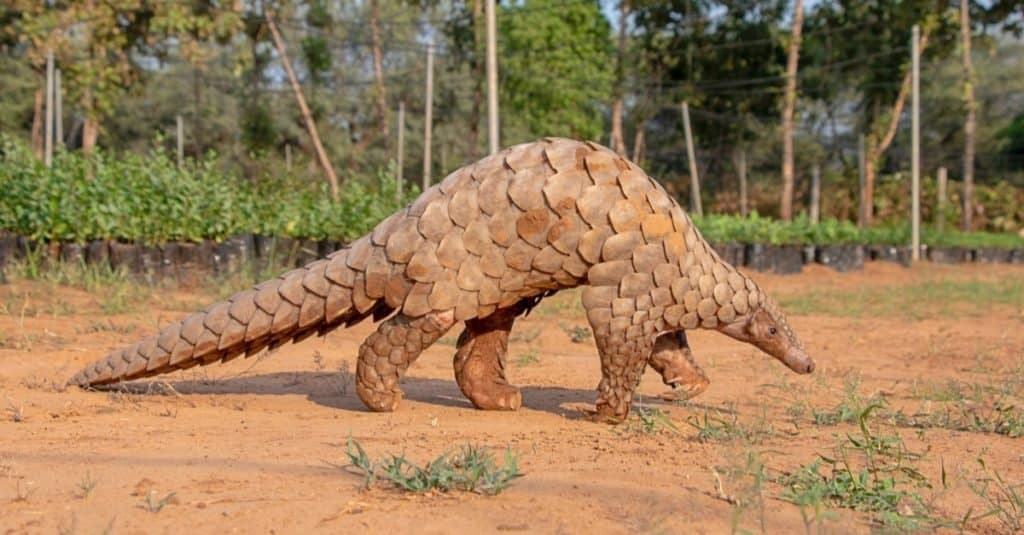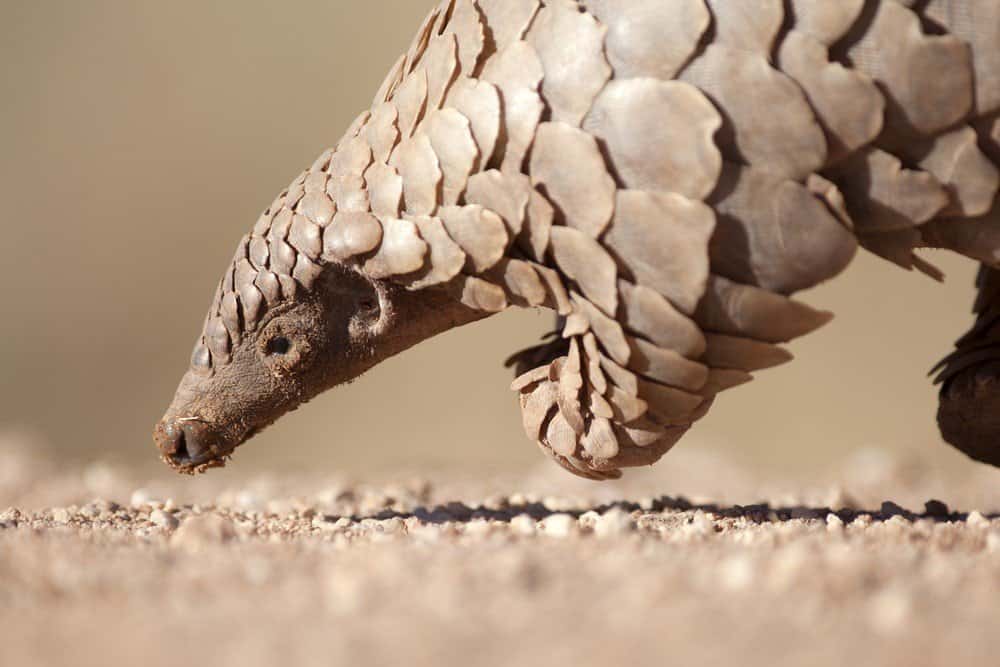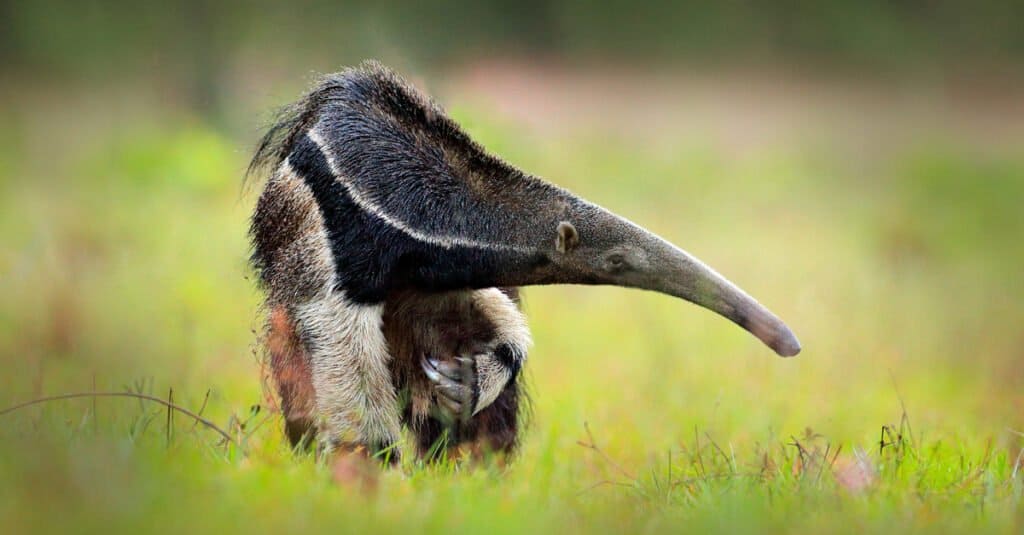There are many animals across the world that eat ants, but few are so well known for it that it’s part of their name! The pangolin and the anteater are two different species, although people mix them up quite often. These interesting critters live in totally different habitats and regions of the world, although they have both evolved to eat the same foods. Today, we are going to compare the two and see what makes them different. Let’s explore: Pangolin vs Anteater!
Comparing a Pangolin and an Anteater

| Pangolin | Anteater | |
|---|---|---|
| Size | Length: 1-3 feet Weight: -73 lbs | Varies with species. Ranges between 3-7 feet long and 40-88 pounds. |
| Armor | Thick keratin scales. | No armor. |
| Defense | Curls into a tight ball. | Long claws. |
| Distribution | Asia and sub-Saharan Africa. | Central and South America. |
| Trafficking | Most trafficked animal in the world. | Little to no trafficking. |
The 5 main differences between a pangolin and an anteater
The main difference between a pangolin and an anteater is that pangolins are smaller and covered in thick, scaly skin. Anteaters are usually larger and covered in hair.
Part of the reason that pangolins and anteaters are so often confused is due to their names. Pangolins are often referred to as “scaly anteaters,” a close name to a “true” anteater. It is true that both animals feed on ants and termites, but they aren’t as closely related as some believe. In fact, the anteater’s closest evolutionary relative is the armadillo, another animal that is often confused with the pangolin.
The best way to tell the difference between a pangolin and an anteater is by checking for any armor. Pangolins are famous for having a scaly, keratinized layer of skin across their bodies that they use for protection from predators. The appearance of a pangolin is often described as a “pine cone” due to the rigid edges of the scales. Anteaters, on the other hand, are just covered in coarse hair.
Aside from physical differences, these two animals live in very different parts of the world. Pangolins can be found in certain regions of Africa and Asia, but the anteater is a uniquely New World mammal. Anteaters are only found in Central and South America. Different species are found in different habitats for both species.
Let’s take a deep dive into these animals and see some more detail about what makes them unique!
Pangolin vs Anteater: Size

Pangolins are usually smaller than anteaters.
©Vickey Chauhan/Shutterstock.com
When it comes to size, the pangolin is almost always smaller. There are a few species that live across the world, but most of them are quite similar in size. On average, pangolins are 12 to 39 inches long and weigh between 4-7 lbs. For perspective, they are about the same size as a small housecat.
Anteaters can be smaller than the pangolin, but the largest species, the giant anteater, is significantly larger. The smallest species of anteater is the silky anteater. This little animal can grow to 18 inches long (including its long tail) and weigh up to a pound. The giant anteater is the largest anteater in the world. It measures up to 6 feet long and can weigh 160 lbs in the wild.
Pangolin vs Anteater: Armor

Pangolins are covered in thick scales for protection.
©2630ben/Shutterstock.com
Part of what makes the pangolin a famous animal is its armor. Pangolins have overlapping scales made of keratin (the stuff that makes hair and nails) covering their entire body. Once the pangolin matures, the scales harden into armor sufficient enough to fend off attacks by predators. These large scales give pangolins the silly appearance of moving pinecones.
Anteaters don’t have any armor across their bodies. Instead, anteaters are covered in dense fur that is usually quite coarse. The only exception to this is the silky anteater, the smallest of the species. Silky anteaters are covered in a fuzzy, downy-soft fur. This special fur is what gives the silky anteater its strange name!
Pangolin vs Anteater: Defense

Anteaters have long claws they use to defend themselves from predators.
©iStock.com/Ivan Mattioli
The pangolin isn’t a large or strong animal. As such, it needs a special way to defend itself from predators. For the pangolin, a solid defense is the best method of survival. When threatened, pangolins curl into tight balls, wrapping their tails around their heads. The sharp edges of the scales make the pangolin tough to comfortably bite, and the hardness of the scales is near impenetrable by claws. Additionally, they are known to release a foul musk, similar to a skunk, when threatened.
The anteater doesn’t have a natural defense mechanism as the pangolin does. Still, the giant anteater is a large animal with massive digging claws on its forepaws. When threatened, the giant anteater stands on its hind legs and shows off those claws to predators in the hopes of dissuading them.
Pangolin vs Anteater: Distribution

Anteaters live in Central and South America.
©Ondrej Prosicky/Shutterstock.com
The pangolin is an Old World mammal that can be found in sub-Saharan Africa and Asia. There are currently four primary species that live in Africa, belonging to the Phataginus and Smutsia genera. Asia is home to another four species located within three genera, Manis, Phataginus, and Smutsia.
There are three species of anteater alive. All three live in Central or South America and expanded into Central America when the Isthmus of Panama was formed.
Pangolin vs Anteater: Trafficking

Pangolins are the most trafficked animal in the entire world.
©Positive Snapshot/Shutterstock.com
Pangolins are some of the most threatened animals in the entire world. They are used for meat and folk medicine, and as such, they are trafficked on black markets internationally. Sadly, the misguided belief that pangolins have special medicinal properties is a large part of their decline. They are often killed or trapped and sold to different markets around the world. China and Vietnam currently have the highest rates of black-market traffic, with around 100,000 a year in those two places alone.
Anteaters aren’t trafficked in the same way that pangolins are. Since they don’t have any unique ivory or scales, they aren’t considered special to international black markets.
The photo featured at the top of this post is © 2630ben/Shutterstock.com
Thank you for reading! Have some feedback for us? Contact the AZ Animals editorial team.






